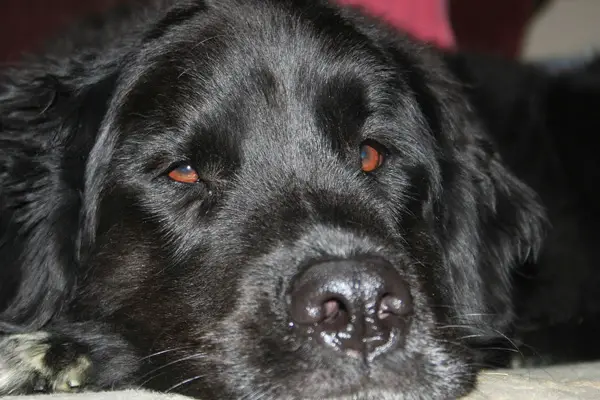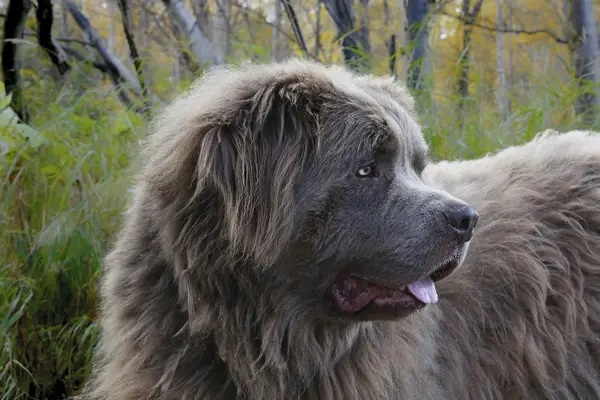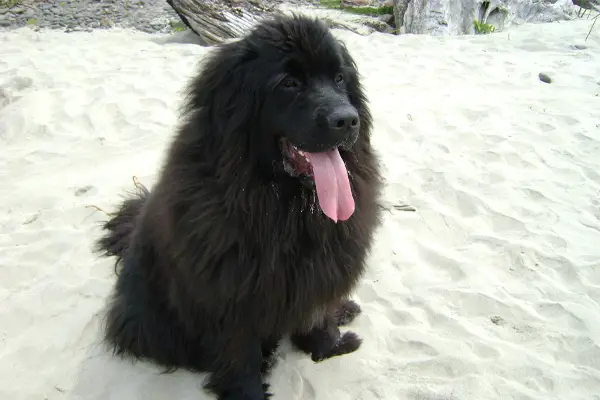Newfoundland is a giant dog breed that can weigh up to 150 pounds. They can grow larger than humans; however, there’s nothing to be afraid of because Newfoundlands are gentle and sweet. They feature a large-sized head with a very soft facial expression.
This dog breed is perfect for families with children. If you remember the animated film Peter Pan, Nana, the dog, which also acts as the children’s babysitter, is a Newfoundland. This is certainly not far from reality as this dog is excellent at handling children.
They are best known to be naturally great swimmers, saving several people from drowning. At the same time, they also make great assistants on land, especially with tracking or pulling a cart.

Newfoundland Statistics
| Dog Breed Group | Working |
| Breed Size | Giant |
| Height | 28 inches (male); 26 inches (female) |
| Weight | 130-150 pounds (male); 100-120 pounds (female) |
| Lifespan | 9-10 years |
Newfoundland Ratings
| Energy level | |
| Exercise needs | |
| Requires attention | |
| Playfulness | |
| Trainability | |
| Shedding | |
| Grooming | |
| Friendly with family | |
| Friendly with kids | |
| Friendly with strangers | |
| Friendly with other dogs | |
| Prey Drive |
Newfoundland History
The Newfoundland dog originated from no other than Newfoundland, a province in Canada. As excellent swimmers, Newfoundlands worked alongside the fishermen of the area. They haul fishnets to the shore, cart the day’s catch, and even help in water rescues.
Unfortunately, there are very few details on how Newfoundland dogs came about. But many believed that they are somehow related to Pyrenean mountain dogs. There is also a theory that they’re a cross between a Tibetan Mastiff and the American Black Wolf, while another theory is that they’re a result of crossing different European breeds around the 15th and 16th centuries.
In the 18th century, Newfoundland was sent to Britain and France, where they gained a lot of popularity.
As the story goes, an English Botanist named Sir Joseph Banks was the one who acquired the Newfoundland dogs. They were then named in 1775 by George Catwright, and in the late 1800s, Professor Albert Heim identified and described the breed.
Sadly, in the 1780s, the dog breed almost went extinct because of restrictions given by the government. It is said that Canadian families had to pay taxes to keep the dog.
The paintings of Sir Edwin Landseer somehow saved the breed by including them in his paintings. And finally, the governor of Newfoundland, Harold MacPherson, made the dog his breed of choice, which made the breed famous again.
By 1860, Newfoundland was shown in England dog shows. And by 1879, the American Kennel Club finally registered the dog breed.
They may no longer be assisting a lot in water rescues, but they are indeed excellent family dogs. They are now one of the most beloved dog breeds because of their versatility and sweetness.

Newfoundland Temperament
Newfoundland dogs are best known for their sweetness despite their giant size. They are the ideal family pets – good with children, intelligent, and aims to please. They thrive for human companionship, and it’s not advisable to leave them alone for long periods.
If you want a Newfoundland dog, it’s best to note that they are more comfortable in a spacious home. They are big, so an apartment living will not work for them. It’s also great if there’s a lake or pond near your place where they can swim because Newfoundlands love water.
To stay fit, they need daily walks, and if you can give him something to do like pulling a cart, he’ll be happier.
They are calm, dignified, and generally quiet. They are very friendly with everyone, so you really can’t expect them to bark at visitors. However, expect that their protective side will come out if you ever get in trouble.
Early socialization and training are needed to maintain Newfoundland’s good temperaments. Although they are generally well-mannered, they need some obedience training to control their independence.
Remember to approach them calmly and patiently. Food will become your best friend to encourage him, and also it’s a great reward.
Newfoundland Care Requirements
- Nutrition: The Newfoundland dog is a giant dog breed, which means they need a lot of calorie intake. This should also be a high-quality and well-balanced diet that contains all the essential nutrients. You can feed your Newfoundland with dry dog food, raw diet, or a home-cooked meal, depending on your preference. If you’re going for commercially dry food, make sure that it meets the needed nutrition such as protein, vitamins, minerals, and antioxidants. Stay away from dry food with fillers and harmful preservatives. A raw diet will consist of organ and muscle meat, bones, raw eggs, and vegetables. If you’re going for this type of diet, make sure to ask for guidance from a vet. For a home-cooked meal, high-quality ingredients are essential. It should contain different types of animal protein and vegetables. You can also add brown rice for some carbohydrates. Stay away from products that might trigger skin allergies, such as weight and soy.
- Grooming: The Newfoundland’s coat sheds seasonally. However, they need brushing at least once a week to remove loose hair and prevent mats and tangles. This will also keep their hair in a healthy state. During the shedding season, you can give a thorough daily brush to reduce hair problems on your furniture. Bathing should also be done occasionally. Newfoundlands don’t get dirty a lot, especially if you’re giving him time to swim. Check his nails regularly and make sure it’s trimmed. Long nails are painful for a dog, especially if he’s the active type.
- Exercise: Newfoundlands are versatile and do well, whether on land or in water. Though they are not the active type, giving them work daily will keep him healthy and happy. They need at least 30 minutes of moderate exercise daily. This can be in the form of daily walks, hike, play, fetch, or, the best of all, swimming. You can also let him participate in canine events to showcase his agility, herding, obedience, rally, and tracking skills.
- Health: Newfoundland dogs are prone to several diseases that you, as an owner, should be aware of. Some serious conditions to watch out are gastric torsion, Subaortic stenosis, cystinuria, hip dysplasia, epilepsy, and elbow dysplasia. They are also prone to some minor conditions like Willebrand’s disease, cataract, osteochondrosis dissecans, and entropion. There are screening tests that need to be conducted to detect some of these diseases. So, it’s best if you have your dog take one to rule them out. At the same time, make sure to watch out for any symptoms and take your dog for regular check-ups.
- Lifespan: The life expectancy of Newfoundlands is 9-10 years.

Famous Newfoundlands
- Seaman: A Newfoundland dog who accompanied Lewis and Clark, American explorers, on their expedition
- Sable Chief: The famous mascot of the 2nd Battalion of the Newfoundland Regiment in World War I
- Tony: A Newfoundland dog called the “Battery dog” because he was always in action; he also joined on battlefields at South Mountain
- Nana: Wendy’s dog in Peter Pan
- Gander: The mascot of Quebec City’s Royal Rifles of Canada
- Brumus: Robert Kennedy’s Newfoundland
- Faithful: President Ulysses Grant’s Newfoundland
- Hector: President Rutherford Hayes’ Newfoundland
- Lara: President James Buchanan’s Newfoundland
Fun Facts About Newfoundlands
- Newfoundlands were largely developed in the 19th century England and America.
- They came from Newfoundland, the place they were named after.
- The breed was first registered with the American Kennel Club in 1879.
- They are excellent swimmers. They can do more than a normal doggie paddle because they can swim underwater.
- They are natural lifeguards; they have saved several people from drowning.
- They can grow larger than people; an average male weighs between 130 and 150 pounds.
- They come in four colors: black, brown, gray, and black and white.
- They drool a lot.
